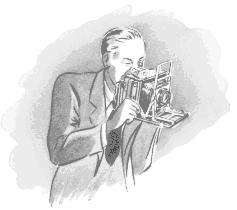| View previous topic :: View next topic |
| Author |
Message |
ANDRE
Joined: 11 Feb 2005
Posts: 16
Location: VA-DC-MD
|
 Posted: Thu Mar 03, 2005 6:39 pm Post subject: Posted: Thu Mar 03, 2005 6:39 pm Post subject: |
 |
|
My ancient Model A ciro-flex often develops a small light leak which shows up in the lower left corner of a print. This exhibits itself as two narrow white bands which run about a quarter of the way across the print.
What, (if anything) can be done to eliminate this problem. |
|
| Back to top |
|
 |
douggrosjean
Joined: 11 Dec 2004
Posts: 46
Location: NW Ohio, USA
|
 Posted: Fri Mar 04, 2005 12:36 am Post subject: Posted: Fri Mar 04, 2005 12:36 am Post subject: |
 |
|
On the Ciro-Flex cameras I have, the light seal is just felt. It seems to me that it could be replaced with new felt, by peeling off the old stuff and gluing on some new.
No, I haven't done this myself yet. But I have some evidence of possible light leaks as well (along the edges of the film).
_________________
Best,
Doug Grosjean
NW Ohion
douggrosjean@gmail.com
Various 35mm SLR and P&S cameras,
Kodak Medalist, Rolleicord, and Ciro-Flex,
Burke & James 4x5 Press, and #10 Cirkut |
|
| Back to top |
|
 |
ANDRE
Joined: 11 Feb 2005
Posts: 16
Location: VA-DC-MD
|
 Posted: Fri Mar 04, 2005 7:51 pm Post subject: Posted: Fri Mar 04, 2005 7:51 pm Post subject: |
 |
|
Thanks Doug, I'll consider your suggestion. However the fuzzies along the inner edge of my old ciro don't look all that bad. I wonder if it is the hinge opening or film advance axle opening where the light come through. Strange thing; the leaks are not consistant from exposure to exposure, that is, they are not in all of the shots taken. But they are always in the very same place.
This is something that I love about a square medium format. I have been framing my compositions in such a way as to be able to crop out the leaks after a flatbed scanning. |
|
| Back to top |
|
 |
douggrosjean
Joined: 11 Dec 2004
Posts: 46
Location: NW Ohio, USA
|
|
| Back to top |
|
 |
45PSS
Joined: 28 Sep 2001
Posts: 4081
Location: Mid Peninsula, Ca.
|
 Posted: Sat Mar 05, 2005 5:56 am Post subject: Posted: Sat Mar 05, 2005 5:56 am Post subject: |
 |
|
Pull that old, dried out, fuzzy stuff out and replace it with some new light seal felt or yarn.
_________________
While a picture may be worth a thousand words, a quality photograph is worth a million.
[ This Message was edited by: 45PSS on 2005-03-04 21:58 ] |
|
| Back to top |
|
 |
ANDRE
Joined: 11 Feb 2005
Posts: 16
Location: VA-DC-MD
|
 Posted: Mon Mar 07, 2005 5:30 pm Post subject: Posted: Mon Mar 07, 2005 5:30 pm Post subject: |
 |
|
OK, I have determined that the old packing needs to be pulled out and replaced. Now what kind of felt do I need and how do I replace it. None of the "professional" photo dealers/labs in downtown DC know what I'm talking about. "Felt? What's that?"
Is this an item that needs to be mail-ordered and if so from where? |
|
| Back to top |
|
 |
t.r.sanford
Joined: 10 Nov 2003
Posts: 812
Location: East Coast (Long Island)
|
 Posted: Tue Mar 08, 2005 4:44 am Post subject: Posted: Tue Mar 08, 2005 4:44 am Post subject: |
 |
|
You can try different things -- I've seen Russian cameras with light baffling that seems to be cotton string dipped in India ink or black paint -- but you might want to look at the Micro Tools website. They have a lot of neat stuff, including light baffle kits:
http://www.micro-tools.com |
|
| Back to top |
|
 |
45PSS
Joined: 28 Sep 2001
Posts: 4081
Location: Mid Peninsula, Ca.
|
 Posted: Tue Mar 08, 2005 7:33 am Post subject: Posted: Tue Mar 08, 2005 7:33 am Post subject: |
 |
|
And thick black yarn would be in keeping with Graflex manifacture, sheet felt for lamp bottoms and general funiture use will work also, got a good hardware store around?
_________________
The best camera ever made is the one that YOU enjoy using and produces the image quality that satifies YOU. |
|
| Back to top |
|
 |
Henry
Joined: 09 May 2001
Posts: 1650
Location: Allentown, Pennsylvania
|
 Posted: Tue Mar 08, 2005 2:31 pm Post subject: Posted: Tue Mar 08, 2005 2:31 pm Post subject: |
 |
|
If you can find gaffer tape, cut it into narrow strips to fit the light trap channels, using a metal straight edge and single-edge razor blade or Xacto knife on a pane of glass. Gaffer tape is a bit like duct tape, but much better: sturdier material and adhesive, and it's black. I have successfully treated 35mm cameras and Graphic roll holders by this method. It's a little tricky getting the tape strips into the channels, because the adhesive wants to grab everything in sight, but with practice come results. You can build up the tape in layers if necessary, and it's all easily removed.
I happened to have all those materials already on hand. If I had to go looking for all this stuff from stratch, I'd probably go instead with black yarn and white glue like Sanford's or Elmer's. |
|
| Back to top |
|
 |
|


